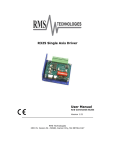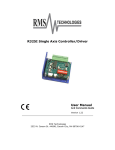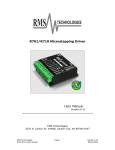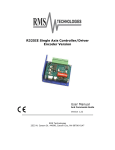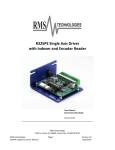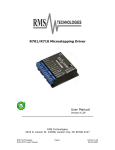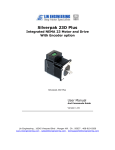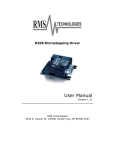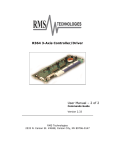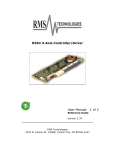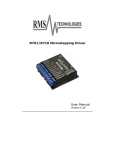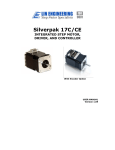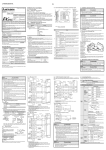Download R325 Single Axis Driver User Manual
Transcript
R325 Single Axis Driver User Manual And Commands Guide Version 1.24 RMS Technologies 2533 N. Carson St. #4698, Carson City, NV 89706-0147 Thank you for purchasing the R325 Single-Axis Driver. This product is warranted to be free of manufacturing defects for one (1) year from the date of purchase. PLEASE READ BEFORE USING Before you start, you must have a suitable step motor, a DC power supply suitable for the motor and a current resistor. The power supply voltage must be between 4 times and 20 times the motor's rated voltage. DISCLAIMER The information provided in this document is believed to be reliable. However, no responsibility is assumed for any possible inaccuracies or omissions. Specifications are subject to change without notice. RMS Technologies reserves the right to make changes without further notice to any products herein to improve reliability, function, or design. RMS Technologies does not assume any liability arising out of the application or use of any product or circuit described herein; neither does it convey any license under its patent rights, nor the rights of others. Note: This equipment has been tested and found to comply with the limits for a Class (A) digital device, pursuant to part 15 of the FCC Rules. These Limits are designed to provide reasonable protection against harmful interferences when the equipment is operated in its installation. This equipment generates, uses and can radiated radio frequency energy and, if not installed and used in accordance with the instruction manual, may cause harmful interference to radio communications. If this equipment does cause harmful interference the user will be required to correct the interference. This Class (A) digital apparatus complies with Canadian ICES-003 Cet appareil numérique de la classe (A) est conforme à la norme NMB-003 du Canada Special Symbols Indicates a WARNING and that this information could prevent injury, loss of property, or even death (in extreme cases). RMS Technologies R325 Single Axis Driver Manual Page 2 Version 1.24 5/29/2013 R325 User Manual Product: Version: Date: R325 1.24 5/29/2013 Version History Version Date Description of Changes 1.10 02/13/2006 New Formatting 1.20 6/7/2007 Added minimum inductance 1.21 8/23/2007 1.22 3/30/2009 1.23 7/7/2010 1.24 5/29/13 Added info on internal resistors and recommended resistors for opto-isolated inputs. Added Appendix B: PF Value Added converter card connection Updated error on voltage page 8. Updated enable/disable pin description on page 8 RMS Technologies R325 Single Axis Driver Manual Page 3 Version 1.24 5/29/2013 Table of Contents 1. FEATURES ......................................................................................5 Pole Damping Technology™ ................................................................................ 5 Optically Isolated Inputs and Output .................................................................. 5 2. ELECTRICAL SPECIFICATIONS .......................................................5 3. OPERATING SPECIFICATIONS .......................................................6 4. MECHANICAL SPECIFICATIONS .....................................................6 Dimensions .................................................................................................................... 6 5. PIN ASSIGNMENTS ........................................................................7 6. CONNECTION SPECIFICATIONS .....................................................8 Connecting the Power ......................................................................................... 9 Connecting the Motor .......................................................................................... 9 Configure the R325 using the DIP Switch.......................................................... 10 DIP Switch Run Current Settings ................................................................................. 10 DIP Switch Hold Current Settings ................................................................................ 10 DIP Switch Step Resolution Settings ............................................................................ 10 7. BASIC STEP AND DIRECTION OPERATION ................................... 11 8. COMMAND TABLES....................................................................... 12 Axis Configuration Commands........................................................................... 12 General Operation Commands ........................................................................... 12 9. COMMANDS ................................................................................. 13 Protocol Syntax ................................................................................................. 13 10. Troubleshooting ........................................................................ 15 11. Appendix A ................................................................................ 16 12. Appendix B ................................................................................ 20 RMS Technologies R325 Single Axis Driver Manual Page 4 Version 1.24 5/29/2013 1. FEATURES • • • Single Axis Driver for Bipolar step motors Operates from +15 to 48 VDC Phase currents from 0.3 to 3.0 Amp Peak NOTE: Phase current of 2.7 Amp and above REQUIRES an additional heatsink, make sure the temperature of the bracket does not exceed 45° C. • • • • Hold current reduction capability with adjustable current and timeout settings Selectable Step Resolution from Full Step to 256x Microstepping Has three optically isolated control inputs and one optically isolated control output Pole Damping Technology™ integrated within driver board Dip switches and a RS485 interface are built-in to the R325 Controller. A USB connection can be used by using the USB485 Converter Card (sold separately). Pole Damping Technology™ Pole Damping Technology™ (PDT) enhances step motor performance by dampening each full step in order to create a more accurate and smooth motion profile. Microstepping the step motor will optimize Pole Damping Technology™. PDT outputs the correct amount of run and hold currents to the motor, at the right time. Thus, it will overcome the step motor’s natural tendency to want to forcefully pull towards the full step ON position. Optically Isolated Inputs and Output The default usage of the three optically isolated inputs is Step, Direction and Disable. The assignment of Disable is fixed; however the other two inputs can be assigned to other functions as part of software customization. For example one can be used for Go-Resume and the other for Stop-Quit. The normal usage of the single optically isolated output is to indicate motion by sending a pulse every time a step is made. 2. ELECTRICAL SPECIFICATIONS Supply Voltage: Phase Current: +15 to 48 VDC 0.3 to 3.0 Amps Peak NOTE: Phase current of 2.7 Amp and above REQUIRES an additional heatsink, make sure the temperature of the bracket does not exceed 45° C. I/O Specifications 3x Optically Isolated Inputs (1 fixed) 1x Optically Isolated Output Minimum Motor Impedance: 1.5 mH Note: The drive may behave unpredictably if the motor you are using has an inductance less than 1.5 mH. RMS Technologies R325 Single Axis Driver Manual Page 5 Version 1.24 5/29/2013 3. OPERATING SPECIFICATIONS Maximum Step Frequency: Operating Temperature: 2.5 MHz Low end – 0° C High end – Dependent on case temperature, bracket temperature must not exceed 45° C Automatic Motor Holding Current reduction available from 0.3 to 2.5 Amps Logic Timing Minimum Step Pulse Width Minimum Step Low Time Maximum Power-Down Recovery Time 200 nanoseconds 200 nanoseconds 20 milliseconds 4. MECHANICAL SPECIFICATIONS Size: 3.00” x 2.94” x 1.42” Weight: 4.8 oz Mounting: Four #6-32 screws, 2.42” x 2.45” Plate: Aluminum, Hard Anodized Dimensions RMS Technologies R325 Single Axis Driver Manual Page 6 Version 1.24 5/29/2013 5. PIN ASSIGNMENTS A 12-pin pluggable terminal strip connector P1 provides power and the step and direction control functions for the module. All of these signals are optically isolated. Open-collector drives are required to provide pulses for Step, levels for Direction, and Disable. The common +ve supply can be +ve 5 to 30 VDC with respect to the signal input; however if the supply is greater than 5 VDC then a resistor must be inserted in series with each signal line to limit the current to 10 mA. Pin No 1 2 3 4 5 6 7 8 9 10 11 12 P1 Configuration Function Common +ve External Step (in) Direction (in) +5 VDC Internal Disable (in) Motor A+ (out) Motor A- (out) Motor B+ (out) Motor B- (out) Fault (out) Power Ground Power Positive P1 Connector – Pin 1 Location CAUTION: Connecting Motor phases (A, A Bar, B, B Bar) to the incorrect location while the R325 is powered will cause the board to burn. Be sure to insert motor phases into Pins 6 through 9, in the order of A, A Bar, B, and B Bar. It is recommended that power is connected last, so that all connections can be checked before power up. A separate three pin connector P3 is provided for the RS485 bus interface P3 Configuration Pin No Function 1 A Input (+ve) 2 Ground 3 B Input (-ve) Mating P1 P2 P3 Connectors Phoenix Contact Amp Amp 1803675 640441-5 640441-3 JP1 - Pin Header RMS Technologies R325 Single Axis Driver Manual Page 7 Version 1.24 5/29/2013 6. CONNECTION SPECIFICATIONS When using the Driver Only portion of the R325, use the dip switches for step resolution and current settings. Using the R325 as a Driver Unit Only If using the R325 as a Driver only, be sure to connect the power supply last. Pin 1: Connect Pin 1 to Pin 4 to use the internal +5VDC. By using the internal +5VDC the I/O’s will no longer be optically isolated. If optical isolation is still desired, use a separate +5VDC supply and connect the POSITIVE end of the supply to Pin 1. The NEGATIVE end will connect with the NEGATIVE end of your pulse generator. Pin 2: Use a pulse generator or function generator to receive pulses into the R325. Connect the POSTIVE end of the pulse generator to Pin 2. The NEGATIVE end will be connected to the NEGATIVE end of the +5VDC supply if using a separate power source. If using the internal +5VDC supply, connect the NEGATIVE end of the pulse generator to Power GROUND. Pin 3: To switch the direction of motor rotation, connect Pin 3 with Pin 11, Power Ground. An open or closed connection to Power Ground will change the direction. Pin 4: This is the internal +5VDC. Use this for testing purposes or if optical isolation of the inputs is not desired. It can output a max of 50 mAmps. Pin 5: To enable the drive leave this Pin open, disable the drive connect Pin 5 with Pin 11 (Power Ground). An open or closed connection to Power Ground will enable and disable the drive, respectively. A closed connection will remove all power to the output motor leads (Pins 6 through 9). Pin 6: Phase A Motor Connection Pin 7: Phase A Motor Connection Pin 8: Phase B Motor Connection Pin 9: Phase B Motor Connection CAUTION: Connecting Motor phases (A, A Bar, B, B Bar) to the incorrect location while the R325 is powered will cause the board to burn. Be sure to insert motor phases into Pins 6 through 9, in the order of A, A Bar, B, and B Bar. It is recommended that power is connected last, so that all connections can be checked before power up. Pin 10: The Fault Output is not available for the basic R325. This feature is used on the R325I and R325IE. Pin 11: Connect the NEGATIVE of the Power Supply to this terminal. Pin 12: Connect the POSITIVE of the Power Supply to this terminal. (+15 to 48VDC) RMS Technologies R325 Single Axis Driver Manual Page 8 Version 1.23 7/7/2010 Connecting the Power The R325 requires a supply voltage between 15-48 VDC. First, connect the positive end of the power supply to positive terminal (Pin 12), and then connect the negative of the power supply to the Ground (Pin 11) on the R325. WARNING! Be careful not to reverse the polarity from the power supply to the driver. Reversing the connection will destroy your driver and void the warranty. Connecting the Motor WARNING! Make sure the power is OFF when connecting or disconnecting motors from the R325. Damage will occur if the power is being supplied. Please refer to your motor documentation for wiring color code. Connect the corresponding Phase from the motor to the proper pin on the R325. Motor Phase Phase A Phase APhase B Phase B- P1 Connector Pin 6 Pin 7 Pin 8 Pin 9 Using the R325 When using the R325 in Step/Direction mode, insure that there are no jumpers on JP1 and proceed to Section 7 – Basic Step and Direction Operation. Using the R325 with more than 5V You can choose to supply the optos with the R325’s internal 5V supply by jumping pins 1 to 4. But if you choose to use more than 5V, for example, a 24V supply and the step pulse train is also a 0 to 24V low-high signal, please use the following recommended resistor to limit the current to 10 mAmps. Note: no resistor will be needed on the actual opto supply line, pin 1. Step & Direction lines have a 470 ohm internal resistor Voltage: 5V 10V 15V Ohms needed: 0 500 1000 Wattage rating: 0 ¼ watt ¼ watt 24V 2000 ¼ watt Disable line has a 1k ohm internal resistor Voltage: 5V 10V Ohms needed: 0 1000 Wattage rating: 0 1/8 watt 24V 3800 ¼ watt RMS Technologies R325 Single Axis Driver Manual Page 9 15V 2000 1/8 watt Version 1.23 7/7/2010 Configure the R325 using the DIP Switch R325 DIP Switch Settings Function 0.3A 0.4A 0.5A 0.6A 0.8A 1.0A 1.2A 1.4A 1.6A 1.8A 2.0A 2.2A 2.4A 2.6A 2.8A 3.0A SW1 ON OFF ON OFF ON OFF ON OFF ON OFF ON OFF ON OFF ON OFF Run Current SW2 ON ON OFF OFF ON ON OFF OFF ON ON OFF OFF ON ON OFF OFF SW3 ON ON ON ON OFF OFF OFF OFF ON ON ON ON OFF OFF OFF OFF SW4 ON ON ON ON ON ON ON ON OFF OFF OFF OFF OFF OFF OFF OFF SW9 OFF OFF OFF ON ON OFF OFF ON ON SW10 OFF OFF OFF OFF OFF ON ON ON ON WARNING: Current of 2.7 Amp and above REQUIRES an additional heatsink, make sure the temperature of the bracket does not exceed 45° C Hold Current (Percent of Run Current) Function SW5 SW6 0% ON ON 33% OFF ON 66% ON OFF 100% OFF OFF Function Full Step* 2X 4X 8X 16X 32X 64X 128X 256X SW7 OFF ON ON ON ON ON ON ON ON Step Resolution SW8 OFF OFF ON OFF ON OFF ON OFF ON *The power must be turned OFF when switching in and out of Full Step mode. Notes: 1. Installing a jumper on JP1 pins 9 and 10 runs the factory test routine RMS Technologies R325 Single Axis Driver Manual Page 10 Version 1.23 7/7/2010 7. BASIC STEP AND DIRECTION OPERATION The four control signals Step, Direction, Disable, and Fault Out are optically isolated, with a common positive connection (usually 5 VDC). The common positive connection (Pin 1) is typically 5 VDC. Each of the inputs is set to TRUE by supplying a signal level 5V below the common positive connection powering the optical isolators. The input is set FALSE by putting the signal within 0.5 VDC below the common positive value. Example: If 5 VDC is supplied to Pin 1 (common positive connection), TRUE is 0V, and FALSE is any value between 4.5 VDC to 5 VDC. For test purposes, and some applications where input isolation is not required, the internal 5 VDC supply at Pin 4 of the I/O connector can be used as the common positive connection, by linking pins 1 and 4 on the connector. If this is done then each input is set TRUE by bringing the voltage level at the input equal to, or more negative than the Power Supply negative connection at Pin 11. With this arrangement Direction, Disable, and Fault Out control can be effected by simple switch closure between the input and the power negative connection at Pin 11. If the Step input is obtained from a Function Generator, then careful adjustment of the Offset control is needed to ensure that the negative level of the input signal is equal to, or more negative than, the power negative connection at Pin 11. The minimum duration of the active (negative) Step input signal level is 200 nanoseconds and also this is the minimum for the inactive (positive) level. This limits the maximum usable step rate to 2.5 MHz. The optimum operating arrangement (minimum power usage) is for a constant width negative going pulse of 200 nanoseconds with the pulse interval varying with pulse rate. For test purposes, setting the Function Generator duty cycle to 50%, and just varying frequency is satisfactory. RMS Technologies R325 Single Axis Driver Manual Page 11 Version 1.23 7/7/2010 8. COMMAND TABLES Axis Configuration Commands Function Hold Timeout Percent Fast Decay Query/New Q/N Q/N Code HT PF Value Numeric Numeric Minimum 100 0 Maximum 5000 3 Default 5000 2 Maximum - Default - General Operation Commands Function Firmware Rev. Query/New Q Code FR Value Numeric Minimum - Communicating with the R325 1. Place a jumper on pins 7 and 8 of JP1. 2. Communicate via RS485 with P3: RS485-232 Converter Card: RMS Technologies R325 Single Axis Driver Manual Page 12 Version 1.23 7/7/2010 USB485 Converter Card: 3. Set up HyperTerminal by selecting correct COM port 4. Settings for HyperTerminal is as follows: 57600, 8 bits, None, 1, None 2. The R325 Driver only version allows for changing the hold timeout settings, the amount of mixed decay, and to check the firmware revision level. 9. COMMANDS (Page per Command Listing) Protocol Syntax Command Format: #<Address><Command><value><CR><LF> Example: #AHT1000<CR><LF> Sets the Hold Timeout for Driver A to 1000 To query a command use the following format Query Format: #<Address><Command><CR><LF> Example: #AFR<CR><LF> Queries Driver A for the current Firmware Revision The response would be in the following format Response Format: *<Address><value> Example: *AFR325100 R325 firmware revision 1.00 <CR><LF> stand for "Carriage Return" and "Line Feed" respectively. These are NOT characters to be typed in. For direct keyboard users, these values are executed when the "Return" key is pressed. For programmers, a "Carriage Return" and "Line Feed" (also known as a "New Line") command needs to be executed after each command. RMS Technologies R325 Single Axis Driver Manual Page 13 Version 1.23 7/7/2010 Command Operand (Case Sensitive) HT 100 -5000 Example #AHT100 Sets the Hold Timeout to 100 mS PF 0-3 #ACD1 Sets Mixed Mode damping to 15% FR - #AFR Description Hold Timeout - Command or Query Default = 5000 - Reads or sets the time interval in milliseconds after any motor movement, before the motor current is changed from Run Current to Hold Current. Percent Fast Decay - Command or Query Default = 2 - Allows the Damping Mode of the driver IC to be set. 0 = Fast Decay 1 = Mixed Mode 15% 2 = Mixed Mode 48% 3 = 100% The optimum setting will vary with motor inductance and step rate; however the default ‘Mixed Mode’ setting will work well with almost all motors. Firmware Revision - Query Only - Returns 3 digit part code followed by 3 digit firmware revision value. Reply *AFR325100 //R325 firmware revision 1.00 RMS Technologies R325 Single Axis Driver Manual Page 14 Version 1.23 7/7/2010 10. Troubleshooting R325 is not functioning correctly Try putting the R325 into TEST mode by placing a jumper on Pins 9 & 10 of JP1. The motor should twitch back and forth slightly if the R325 is functioning properly. R325 not moving the motor (Step/Dip) Verify that the 5V is being supplied to Pin 1. The R325 is causing the motor to vibrate and jitter back and forth Are the Motor phases switched? Be sure to check that motor wires are connected to Pins 6 through 9, in the order of A, A Bar, B, B Bar. To check which wires belong to one phase, take a Meter to measure resistance between any two wires. If there is a finite value between two of them, insert the wires into pins 6 and 7, OR pins 8 and 9. Insert the remaining two wires accordingly. Technical Support By Telephone: 408-919-0200 (Mon.-Fri., 8:00 a.m.-5:00 p.m.) On the Web: www.linengineering.com Our technical support group is glad to work with you in answering your questions. If you cannot find the solution to your particular application, or, if for any reason you need additional technical assistance, please call technical support at 408-919-0200. RMS Technologies R325 Single Axis Driver Manual Page 15 Version 1.23 7/7/2010 11. Appendix A: Recommended Cable Recommended Cable Configurations: DC Supply to Driver Cable length, wire gauge and power conditioning devices play a major role in the performance of your RMS Technologies Driver and Motor. NOTE: The length of the DC power supply cable to the Driver should not exceed 50 feet. Example A – Cabling Under 50 Feet, DC Power Example A demonstrates the recommended cable configuration for DC power supply cabling under 50 feet long. If cabling of 50 feet or longer is required, the additional length may be gained by adding an AC power supply cable. Correct AWG wire size is determined by the current requirement plus cable length. Please see the Driver Supply Cable AWG Table in this Appendix. RMS Technologies R325 Single Axis Driver Manual Page 16 Version 1.23 7/7/2010 NOTE: These recommendations will provide optimal protection against EMI and RFI. The actual cable type, wire gauge, shield type and filtering devices used are dependent on the customer’s application and system. Driver Supply Cable AWG Table 1 Amp (Peak) Length (Feet) 10 25 50* 75* 100* Minimum AWG 20 20 18 18 16 2 Amps (Peak) Length (Feet) 10 25 50* 75* 100* Minimum AWG 20 18 16 14 14 3 Amps (Peak) Length (Feet) 10 25 50* 75* 100* Minimum AWG 18 16 14 12 12 * Use the alternative methods illustrated in Examples B and C when the cable length is ≥ 50 feet. Also, use the same current rating when the alternate AC power is used Driver Supply Cable Wire Size NOTE: Always use Shielded/Twisted Pairs for the Driver DC Supply Cable, the AC Supply Cable and the Driver to Motor Cable. RMS Technologies R325 Single Axis Driver Manual Page 17 Version 1.23 7/7/2010 Recommended Cable Configurations: Driver to Motor Cable length, wire gauge and power conditioning devices play a major role in the performance of your Driver and Motor. NOTE: The length of the DC power supply cable between the Driver and the Motor should not exceed 50 feet. Example A demonstrates the recommended cable configuration for the Driver to Motor cabling under 50 Feet long. Correct AWG wire size is determined by the current requirement plus cable length. Please see the Driver to Motor Cable AWG Table in this Appendix. Example A - Cabling Under 50 Feet, Driver to Motor If cabling of 50 feet or longer is required, the additional length can be gained by adding Common Mode Line Filters (2x) *L ≈ 0.5 MH * 0.5 MH is a typical starting point for the Common Mode Line Filters. By increasing or decreasing the value of L you can set the drain current to a minimum to meet your requirements. RMS Technologies R325 Single Axis Driver Manual Page 18 Version 1.23 7/7/2010 Driver to Motor Cable AWG Table 1 Amp (Peak) 5 Amp (Peak) Length (Feet) 10 25 50 75 100 Length (Feet) 10 25 50 75 100 Minimum AWG 20 20 18 18 16 Minimum AWG 16 16 14 12 12 2 Amp (Peak) 6 Amp (Peak) Length (Feet) 10 25 50 75 100 Length (Feet) 10 25 50 75 100 Minimum AWG 20 18 16 14 14 Minimum AWG 14 14 14 12 12 3 Amp (Peak) 7 Amp (Peak) Length (Feet) 10 25 50 75 100 Length (Feet) 10 25 50 75 100 Minimum AWG 18 16 14 12 12 Minimum AWG 12 12 12 12 12 4 Amp (Peak) Length (Feet) 10 25 50 75 100 Minimum AWG 18 16 14 12 12 Driver to Motor Supply Cable Wire Size NOTE: These recommendations will provide optimal protection against EMI and RFI. The actual cable type, wire gauge, shield type and filtering devices used are dependent on the customer’s application and system. NOTE: Always use Shielded/Twisted Pairs for the Driver DC Supply Cable, the AC Supply Cable and the Driver to Motor Cable. RMS Technologies R325 Single Axis Driver Manual Page 19 Version 1.23 7/7/2010 12. Appendix B: PF Value For applications requiring ultimate smoothness of motion and extreme accuracy, the R325 driver can be programmed via RS485 to change the Percent Fast Decay rate, or, the PF value. The Percent Fast Decay default is 2, or a mixed mode of 48%. Mixed mode is a damping technique done to the driver IC. The following values indicate the choices for Percent Fast Decay: PF Values (0 through 4): 0 = Fast Decay 1 = Mixed Mode 15% 2 = Mixed Mode 48% 3 = 100% Generally speaking, applications that run at slow speeds are recommended to use a PF value of 1 or less. Fast speeds should use a PF value of 2 or more. Since the best PF value is dependent on the motor winding, loads, power supply voltage, and other factors, it is best to use an oscilloscope and a current probe device to view the current waveform and try different PF values. The following examples show good and bad waveforms when choosing different PF values. • • • PF value 1 Slow speeds Good waveform RMS Technologies R325 Single Axis Driver Manual Page 20 Version 1.23 7/7/2010 • • • PF value 2 Slow speeds Bad waveform • • • PF value 1 Fast speeds Bad waveform RMS Technologies R325 Single Axis Driver Manual Page 21 Version 1.23 7/7/2010





















